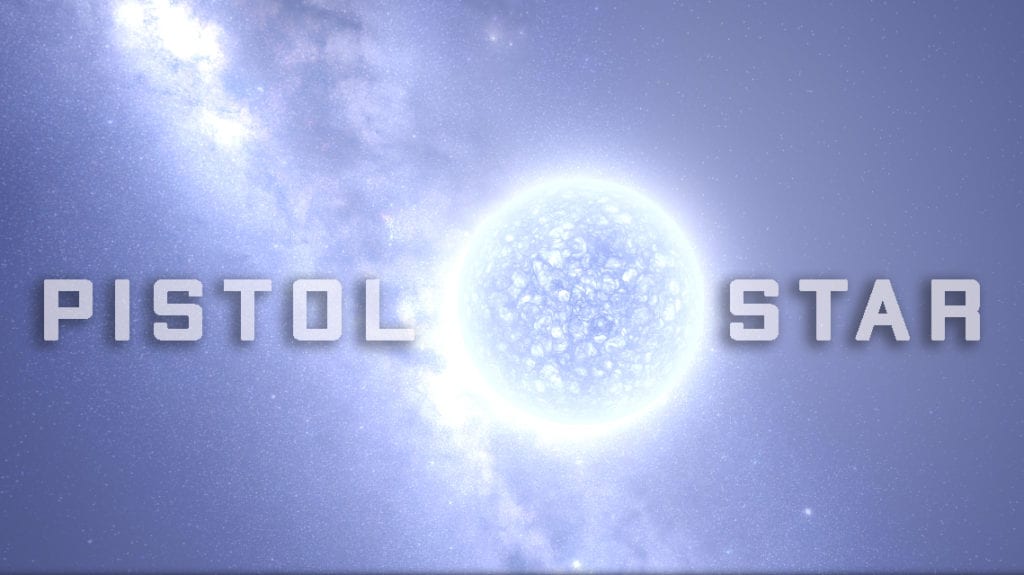
The Pistol Star– Facts in brief:
What is it? –
The Pistol Star is a blue hypergiant star. It is one of the most luminous known stars in the Milky Way.
This blue hypergiant star is located around 25,000 light years from Earth (8,000 parsecs), within the Constellation Sagittarius. It is also known as V4647 sgr, or V4647 Sagittarii. Considered a young massive star it is located within the Pistol Nebula, which is close to the galactic center of our galaxy.
What is a Nebula?
A Nebula is a massive cloud of gas and dust in Space.
Some Nebulae are formed when a star explodes and then dies, as is the case with a Supernova. Sometimes they can act as Star nurseries, which are the areas where new Star formation takes place.
Nebulae are the spaces in between the stars also referred to as interstellar space.
There are several types of Nebulae:
- Bright Nebulae, Emission Nebulae, Reflection Nebulae, Dark Nebulae and Planetary Nebulae
FACT: a ‘reflection nebula’ is an interstellar cloud that should be a dark nebula (a molecular cloud) however its interstellar dust reflects light from a nearby bright star and it reflects the light, hence the name.
The Pistol Nebula
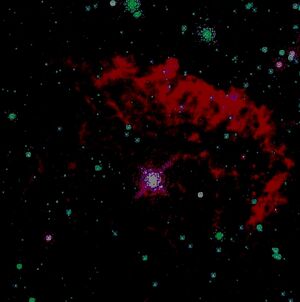
The Pistol Nebula is in Constellation Sagittarius and surrounds the Pistol Star.
In terms of distance, the Pistol Star and its surrounding nebula are located around 25,000 light years from Earth in the Quintuplet Cluster (named due to its 5 brightest stars but in fact it contains hundreds more).
How was it formed?
It is estimated that thousands of years ago the Pistol Star expelled ionized gas and this now forms part of the Pistol Nebula. The Pistol Nebula contains around 9.3 solar masses of this expelled ionized gas.
Visually, the Pistol Nebula appears as the shape of a rectangle and the material that was ejected forms two shells that are centered on the Pistol Star.
The Pistol Nebula completely surrounds the Pistol Star with its largest shell spanning 4 light years and its outer shell contains gas that which expands at a velocity of 60km/s.
It is the hot Wolf-Rayet stars within the Quintuplet Cluster that are responsible for ionizing the Pistol Nebula and creating an interaction with their strong stellar winds.
Properties of the Pistol Star
Dimensions
The Pistol Star is an extremely luminous and massive star and the central Star in the Pistol Nebula.
Mass
The mass of the Pistol Star is uncertain.
The initial mass of the Pistol Star was thought to be over 100 times as big as our Sun. However, this estimate has since been revised since pistol Star began shedding solar masses of material and has since suffered extreme mass loss.
It is thought to have expelled around 10 solar masses of material, 4,000 to 6,000 years ago, and is now it is believed to measure much less in mass.
The current thinking is that it has a mass of 27.5 solar masses, although it could be more.
Radius
Pistol Star has a radius of 306 times that of the Sun (written as 306 R)and registers around 1,953 AU on the astronomy radius scale.
Strength of its Stellar wind
The stellar wind associated with the Pistol Star is much stronger than that of the Sun. It is estimated to be over 10 billion times more powerful than the Sun.
How bright is this Pistol Star
The Pistol Star is a candidate blue variable star (c LBV) and is one of the most luminous stars of all the known stars.
It is measured as having a luminosity of 1,600,000 times brighter than the Sun and estimated to radiate as much energy in 20 seconds as our Sun radiates over a year.
It was once thought to be the brightest star in the night sky however over time this claim was adjusted as it was discovered that another star had this claim to fame – known as Eta Carinae.
Eta Carinae, one of the most massive binary star systems known, is now considered to be 50 million times more luminous than the Sun.
The Pistol Star is about one third of the luminosity of the Eta Carinae binary star system. Without the interstellar dust that dims our vision of this star it would be visible by naked eye as a fourth magnitude star.
Where is it located? –
The Pistol Star is one of many young stars, within the dense open cluster known as the Quintuplet Cluster (a set of 5 massive stars hidden in dust, but revealed by infrared observations).
It is located approximately 100 light years from the Galactic Center, the center of the galaxy we call the Milky Way.
FACT: the Galactic Center, or Galactic Centre, is a supermassive black hole and the rotational center of our Milky Way galaxy. It is not possible to view it at visible, ultraviolet, or even soft or low-energy X-ray wavelengths. This is because of the interstellar dust along its line of sight.
The Quintuplet Cluster is located around 26.000 light years from Earth in the direction of Sagittarius. It has extremely luminous Stars, including Red Supergiants.
It’s made up of 5 massive Stars that appear to be hidden in dust. Also, it is host to two extremely rare luminous blue variable stars (lbv) – the Pistol Star and V4650 sgr.
The Pistol Star was discovered in the early 1990s and captured by the NASA Hubble Space Telescope, although its relationship to the Pistol Nebula was not realized until 1995.
In the early 1990s further observations revealed that the stars in the Quintuplet cluster were much more evolved than originally thought.
They were identified and classified into different types of stars, 2 Wolf-Rayet stars, one as a luminous blue variable and several others as red supergiant stars and are some of the largest stars in the Milky Way.
The color of the Pistol Star
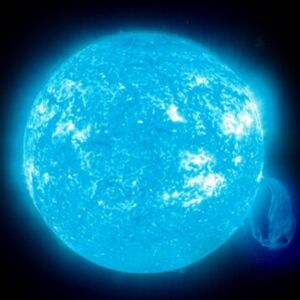
The Pistol Star is classified as a luminous Blue Variable type of Star (LBV), which according to the spectral type of this Star classifies it as a blue colored Star.
Where can it be seen?
Firstly, the Pistol Star is not visible by the naked eye.
Co-ordinates of a right ascension, or left ascension and their declination are used to locate all of the notable objects in the sky
The Pistol Star lies at a 17 hours 46 minute right ascension, and a declination of -28 degrees.
The right ascension – is the angular distance of any sky object along the celestial equator from the March (Spring) equinox.
- If it has a negative number it is west of the March equinox.
The declination – is the angle of the sky object from the celestial equator.
- If it has a negative number it indicates it is located in the southern hemisphere
How was it formed, found and named?
The Pistol Star is a blue hypergiant star. It gets its name from the pistol-like shape of the surrounding Pistol Nebula that it illuminates.
The Pistol Star became so big that it made its own nebula by ejecting around 10 solar masses of itself.
Don Figer, an astronomer working at UCLA, discovered it in the early 1990s, using the NASA Hubble Space.
Figer co-wrote papers, (available by doi or the internet) on the subject of the contents of the Quintuplet Cluster. As well as the properties of the Wolf-Rayet Stars and the Pistol Star. He did this with two colleagues from UCLA, Ian Mclean and Mark Morris. As well as Francisco Najarro, from the institute of Astronomy and Astrophysics at the Munich University.
The age of the Pistol Star
It is not certain what age the Pistol Star is or how long it is likely to continue to survive.
One estimate of the age of Pistol Star is around 4 million years, and it is expected to finish in a supernova or hypernova, in the next 1-3 million years.
How can you identify Pistol Star?
The simplest method for spotting any particular Star from Earth is to first of all locate an easy to recognize neighboring Constellation or object in the night sky.
The Constellation Sagittarius would be a good starting location for finding the Pistol Star. The Pistol Star is not considered to be a part of the Constellation of Sagittarius as is commonly thought, however it is located within its borders.
How do we obtain the images of Stars from Space?
Images of the different Stars and nebulae have been captured using a professional large telescope, such as the NASA Spitzer Space Telescope, with a near infrared camera and multi-object spectrometer.
The IRAC uses an 8-micron detector meaning it operates at a wavelength of 8 microns.
The Astrophysical Journal is a monthly scientific publication covering the areas of astrophysics and astronomy. It has provided images and observations of the Pistol Star and the Quintuplet Cluster.
Supernova Remnants
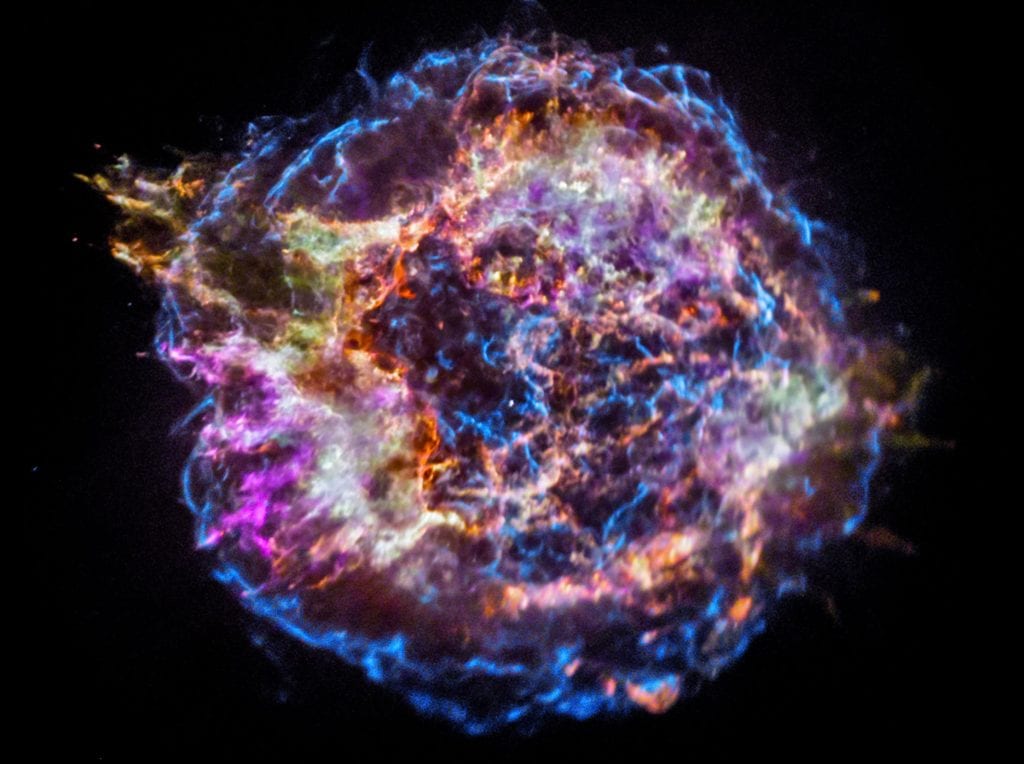
A supernova remnant is the structure that’s left after a star explodes in a supernova.
There are 3 types of supernova remnants: shell-like, composite and mixed-morphology (or thermal composite).
It is anticipated that the existence of the Pistol Star will end in a supernova.
The celestial pole
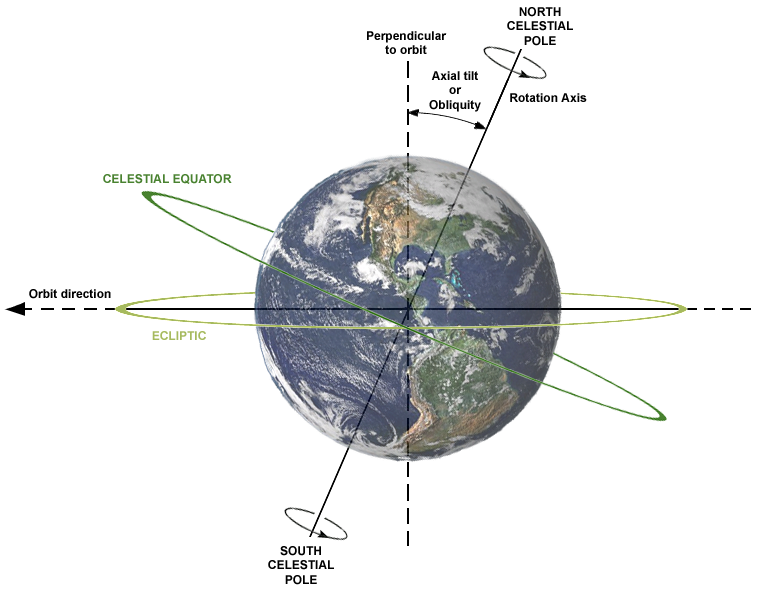
The celestial pole defines the poles of the celestial equatorial coordinate system.
An object at the Celestial pole has a declination of 0 degrees.
- The declinations for the north celestial pole is +90 degrees
- The declinations for the south celestial pole is -90 degrees
The celestial poles are not permanently in a fixed position against the background of the stars as everything moves in Space.
The Pistol Star is located in the Southern celestial sky at a -28 degrees declination, and an average 17 hours, 46min right ascension.
Fun Facts about Stars – Did you know that?
- The rate of formation of stars in a starburst galaxy is more than 10 times faster than the star formation in the Milky Way galaxy
- The planet Jupiter is often cited when making size comparisons between planets or stars. The Jupiter mass is a unit of mass equal to the total mass of planet Jupiter
- The Star we call The Sun does not belong to any constellation.
- The center of a Galaxy does not contain a Giant Star it contains a Supermassive Black Hole.
- A Red Dwarf is not a Dwarf Planet it is a Star. Most common Stars are Red Dwarf (cool Stars)
Commonly Asked Questions
Q. What prevents us seeing the Stars in the night sky?
A. Light pollution, fog, city lights and artificial lights all limit our visibility of the objects in the sky at night.
Q. Will the locations of Stars change over time?
A. Stars are continually on the move.
The images we form in our imagination to make objects and patterns out of constellations have already shifted over time.
As we view the night skies from Earth they are likely to continue to shift. Possibly in time, the images may look very different.
SOURCES:
- Pistol Star Image – https://beyond-universe.fandom.com/wiki/Pistol_Star?file=B.PNG
- Supernova Remnant – Cassiopeia A. Credit: NASA/CXC/SAO – https://scitechdaily.com/lonely-origin-of-cassiopeia-a-revealed-one-of-the-most-famous-supernova-remnants
- Celestial Pole – By I, Dennis Nilsson, CC BY 3.0, https://commons.wikimedia.org/w/index.php?curid=3262268
- Color of Pistol star – https://rebuild-the-universe.fandom.com/wiki/Pistol_Star
- Pistol Nebula – https://rebuild-the-universe.fandom.com/wiki/Pistol_Nebula